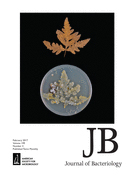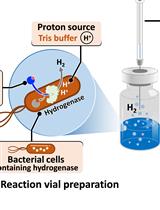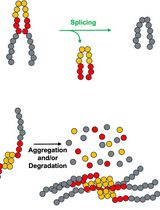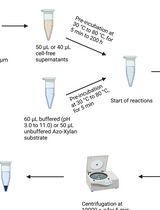- EN - English
- CN - 中文
The Sulfur Oxygenase Reductase Activity Assay: Catalyzing a Reaction with Elemental Sulfur as Substrate at High Temperatures
硫加氧还原酶活性测定: 高温条件下催化以元素硫为底物的反应
发布: 2017年07月20日第7卷第14期 DOI: 10.21769/BioProtoc.2403 浏览次数: 7160
评审: Dennis NürnbergAnonymous reviewer(s)
Abstract
The sulfur oxygenase reductase (SOR) reaction is a dioxygen-dependent disproportionation of elemental sulfur (S0), catalyzed at optimal temperatures between 65 °C and 85 °C. Thiosulfate and sulfite are formed as oxidized products as well hydrogen sulfide as reduced product. External co-factors are not required. Usually, the SOR assay is performed in a milliliter scale in S0-containing Tris-buffer at high temperatures followed by colorimetric product quantification. In order to make the SOR assay more sensitive and better reproducible, several modifications were implemented compared to the original SOR assay (Kletzin, 1989). Here we present the modified SOR assay and the following quantification of the reaction products.
Keywords: Sulfur oxygenase reductase (硫加氧还原酶)Background
Sulfur oxygenase reductases (SOR) catalyze a dioxygen-dependent disproportionation of elemental sulfur with sulfite, thiosulfate and hydrogen sulfide as detectable products. The initially found SORs were derived from hyperthermophilic, sulfur-oxidizing Archaea and Bacteria. The reported temperature optima were between 65 °C and 85 °C and the pH optima between pH 5 and pH 7.4 (Emmel et al., 1986; Kletzin, 1989; Sun et al., 2003; Pelletier et al., 2008). Surprisingly, SORs derived from the mesophilic bacterium Halothiobacillus neapolitanus (Veith et al., 2012) and the alkalihalophilic Thioalkalivibrio paradoxus (Rühl et al., 2017) also had temperature optima of around 80 °C at pH 8.4 and pH 9.0, respectively. Most SORs can be produced in E. coli by heterologous gene expression and only the first descriptions of the enzyme were derived from proteins purified from their native sources (Emmel et al., 1986; Kletzin, 1989; Pelletier et al., 2008). Today, sor genes are found in approximately 35 different Bacteria and Archaea (Rühl et al., 2017).
Usually, SORs have a stoichiometry between 4:1 and 10:1 of oxidized (thiosulfate and sulfite) and reduced products (hydrogen sulfide). The oxidation and reduction reactions could not be separated by site-directed mutagenesis, although the product stoichiometries may vary (Veith et al., 2012). So far, the only exception is the Thioalkalivibrio paradoxus SOR with stoichiometries of 100-1,000:1, which makes the enzyme an oxygenase with almost no reductase activity (Rühl et al., 2017). The thiosulfate:sulfite ratio increases with temperature and pH (Kletzin, 1989; Veith et al., 2012; Rühl et al., 2017). Therefore, the bulk of the thiosulfate is most likely formed rapidly by a non-enzymatic reaction between sulfur and sulfite at pH values above 6 and temperatures exceeding 70 °C.
The original SOR activity assay (Kletzin, 1989; Urich et al., 2004) involves shaking of an aliquot of the enzyme in a buffer containing elemental sulfur at the given reaction temperature coupled to the colorimetric determination of the amount of products at different time points. Product determination is also possible using HPLC (e.g., Rethmeier et al., 1997). However the number of samples that can be processed per day is higher using the colorimetric assays because of the longer time required for each HPLC run. Specific SOR activities were in the range of 10 U/mg of protein for the Acidianus ambivalens SOR and 40 U/mg for the Halothiobacillus enzyme, both determined with the original enzyme assay.
After developing several modifications, the activity assay became more sensitive, resulting in higher product formation and lower amount of the required enzyme together with a reduced incubation time of the enzyme assay (Table 1). The original assay (Kletzin, 1989) was performed in stoppered glass vials with the enzyme being added at room temperature prior to incubation. All vials were transferred simultaneously to a shaking bath with preheated heating liquid. In order to stop the reaction, the vials were transferred sequentially into an ice bath. Urich et al. (2004) modified the procedure for the use of 1.5 ml plastic reaction vials and thermomixers but kept the order of the steps. In the modified procedure, the enzyme solution is added last to the 0 min time point immediately before transfer of the entire set of vials to an ice bath. Thus, all vials remain at the assay temperature for exactly the same time minimizing background effects. Here we describe the modified SOR activity assay and the quantification of its three reaction products.
Table 1. Incubation conditions for the original and modified SOR enzyme assays
Materials and Reagents
- Safe-lock reaction vials, 1.5 ml (SARSTEDT, catalog number: 72.690.001 )
- Micro cuvettes, polystyrene (SARSTEDT, catalog number: 67.742 )
- 37% [wt/vol] formaldehyde (Merck, catalog number: 104003 )
- Double deionized water (ddH2O; 18.2 MΩ at 25 °C)
- Tris(hydroxymethyl)aminomethane (Tris base) (Carl Roth, catalog number: 5429.2 )
- 32% [wt/vol] hydrochloric acid (HCl) (Carl Roth, catalog number: P074.4 )
- Tween 20 (Carl Roth, catalog number: 9127.2 )
- Sulfur flower (AppliChem, catalog number: A1687 )
Note: This product has been discontinued; alternative product: Merck, catalog number: 107983 . - Methylene blue (Merck, catalog number: 115943 )
- Sodium thiosulfate pentahydrate (Merck, catalog number: 106513 )
- Fuchsine (Merck, catalog number: 105226 )
- Sulfuric acid (Carl Roth, catalog number: 9316.2 )
- Sodium sulfite (Merck, catalog number: 106657 )
- Zinc acetate dihydrate (Merck, catalog number: 108802 )
- Acetic acid (Carl Roth, catalog number: 3738.5 )
- Dimethyl-4-phenylenediamine dihydrochloride (Merck, catalog number: 103067 )
- Iron-(III)-chloride hexahydrate (Carl Roth, catalog number: 7119.1 )
- 20% [wt/vol] ammonium sulfide solution (Sigma-Aldrich, catalog number: A1925 )
Note: This product has been discontinued; alternative product: Merck, catalog number: 105442 . - SOR assay buffer (see Recipes)
- Methylene blue solution (see Recipes)
- Sodium thiosulfate solution (1 mM) (see Recipes)
- Fuchsine solution (see Recipes)
- Sodium sulfite solution (1 mM) (see Recipes)
- Zinc acetate solution (see Recipes)
- Dimethyl-4-phenylenediamine dihydrochloride solution (see Recipes)
- Iron-(III)-chloride solution (see Recipes)
- Ammonium sulfide solution (1 mM) (see Recipes)
Equipment
- Polypropylene Griffin beaker 250 ml (Carl Roth, catalog number: 2875.1 )
- Pipettes L20, L200, L1000 (Abimed LABMATE Optima)
Note: This product has been discontinued; alternative product: Gilson, catalog number: F167350 . - Magnetic stirrer (e.g., IKAMAG RET; IKA)
- Thermomixer basic (shaking heat block; CellMedia, Elsteraue, Germany)
- pH meter (Xylem, WTW, model: inoLab pH 720 ) with SenTix 41 pH electrode (Xylem, WTW, catalog number: 103635 )
Note: The product “Xylem, WTW, model: inoLab pH 720 ” has been discontinued. - Centrifuge Heraeus Pico 17 Microcentrifuge (Thermo Fisher Scientific, Thermo ScientificTM, model: HeraeusTM PicoTM 17 , catalog number: 75002410)
- Spectrophotometer (e.g., Beckmann Coulter, model: DU-640 )
- Ultrasound device (Emerson Electric, Branson, model: Sonifier 250 , catalog number: 100-132-868) equipped with a macrotip
Software
- Microsoft Excel 365 (Microsoft)
Procedure
文章信息
版权信息
© 2017 The Authors; exclusive licensee Bio-protocol LLC.
如何引用
Rühl, P. and Kletzin, A. (2017). The Sulfur Oxygenase Reductase Activity Assay: Catalyzing a Reaction with Elemental Sulfur as Substrate at High Temperatures. Bio-protocol 7(14): e2403. DOI: 10.21769/BioProtoc.2403.
分类
微生物学 > 微生物生物化学 > 蛋白质 > 活性
生物化学 > 蛋白质 > 活性
您对这篇实验方法有问题吗?
在此处发布您的问题,我们将邀请本文作者来回答。同时,我们会将您的问题发布到Bio-protocol Exchange,以便寻求社区成员的帮助。
Share
Bluesky
X
Copy link













